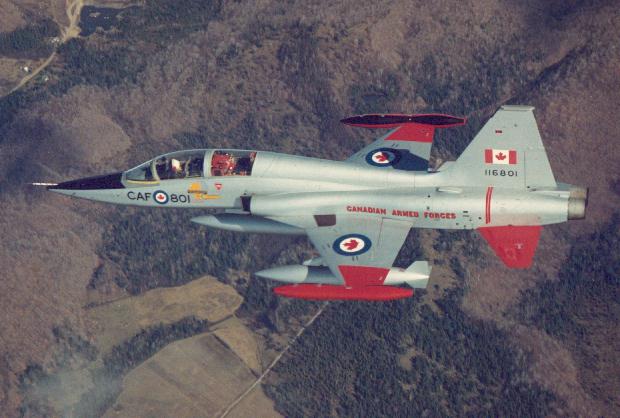Within the annals of the Royal Dutch Air Force there's one plane that will always stand out, in both performance and heritage: the NF5.

When in 1966 the decision was made to replace the aging Republic F84 Thunderstreak and Lockheed T33 "Shooting star", the most promising replacement was the Northrop F5 "Freedom fighter" but when a delagation of Dutch pilots tried the F5 in the USA they found a few points that were not in their favor and Northrop aviation were unwilling to change the design to meet the demands for the Dutch Air force. But in Canada where the F5 was built under licence by Canadair they had no such obligations and were willing to listen to what the Dutch had to say. By that time, the Canadians already had modified the F5 platform to their own needs resulting in the CF5 which differed from the normal F5 by having more powerful engines, a wider fuselage to carry more fuel, different avionics, a tougher undercarriage and thicker wings to carry a bigger load. The CF5 was much more in tune with what the Dutch were after.

The Two seat version of the Canadair CF5 in flight.
In addition to the specifications that were in the CF5, the Dutch also wanted their aircraft to have different leading edge slats on the wings, improving maoeuverability, more simplified avionics, an arrester hook (a hook at the back of the aircraft meant to snatch up a cable at the beginning of a short runway, to stop the aircraift, so it could operate from shorter runways than the regular USA build F5) and a strengthened windscreen to prevent damage from bird hits. A deal was struck and the Canadians made 105 NF5 for the RNAF, consisting of 75 NF5A one seater aircraft and 30 NF5B two seater aircraft.
But in the USA Northrop aviation had been paying attention: perhaps the Dutch were onto something after all. The wider fuselage, tougher undercarriage, tougher windscreen, arrester hook, the leading edge slats on the thicker than normal wings and the more powerful engines made for a damn powerful performer, there was money to be made here... The result was the official Northrop built version of the NF5: The F5E Tiger.

The Dutch flew their NF5 aircraft until the early nineties when they were replaced by the General Dynamics F16 "Falcon" the NF5 airframes were then sold to Greece, Venezuela and Turkye who are still flying them today.
But the tale doesn't end there, when in the seventies Northrop produced the prototype of what would eventualy become the F18 Hornet they had a mock up aircraft done up in the colors of the RNAF. Seeing as how the F18 basically is a scaled up version of the F5E the assumption was made that the Dutch given the fact that they partly inspired the specs of the Hornet would probably first inline to buy it. But the truth was different RNAF never bought or flew the Hornet, opting to buy the General Dynamics F16 instead.

When in 1966 the decision was made to replace the aging Republic F84 Thunderstreak and Lockheed T33 "Shooting star", the most promising replacement was the Northrop F5 "Freedom fighter" but when a delagation of Dutch pilots tried the F5 in the USA they found a few points that were not in their favor and Northrop aviation were unwilling to change the design to meet the demands for the Dutch Air force. But in Canada where the F5 was built under licence by Canadair they had no such obligations and were willing to listen to what the Dutch had to say. By that time, the Canadians already had modified the F5 platform to their own needs resulting in the CF5 which differed from the normal F5 by having more powerful engines, a wider fuselage to carry more fuel, different avionics, a tougher undercarriage and thicker wings to carry a bigger load. The CF5 was much more in tune with what the Dutch were after.

The Two seat version of the Canadair CF5 in flight.
In addition to the specifications that were in the CF5, the Dutch also wanted their aircraft to have different leading edge slats on the wings, improving maoeuverability, more simplified avionics, an arrester hook (a hook at the back of the aircraft meant to snatch up a cable at the beginning of a short runway, to stop the aircraift, so it could operate from shorter runways than the regular USA build F5) and a strengthened windscreen to prevent damage from bird hits. A deal was struck and the Canadians made 105 NF5 for the RNAF, consisting of 75 NF5A one seater aircraft and 30 NF5B two seater aircraft.
But in the USA Northrop aviation had been paying attention: perhaps the Dutch were onto something after all. The wider fuselage, tougher undercarriage, tougher windscreen, arrester hook, the leading edge slats on the thicker than normal wings and the more powerful engines made for a damn powerful performer, there was money to be made here... The result was the official Northrop built version of the NF5: The F5E Tiger.

The Dutch flew their NF5 aircraft until the early nineties when they were replaced by the General Dynamics F16 "Falcon" the NF5 airframes were then sold to Greece, Venezuela and Turkye who are still flying them today.
But the tale doesn't end there, when in the seventies Northrop produced the prototype of what would eventualy become the F18 Hornet they had a mock up aircraft done up in the colors of the RNAF. Seeing as how the F18 basically is a scaled up version of the F5E the assumption was made that the Dutch given the fact that they partly inspired the specs of the Hornet would probably first inline to buy it. But the truth was different RNAF never bought or flew the Hornet, opting to buy the General Dynamics F16 instead.










Comment